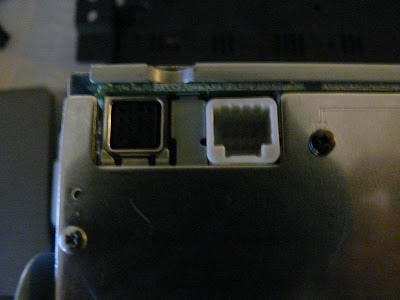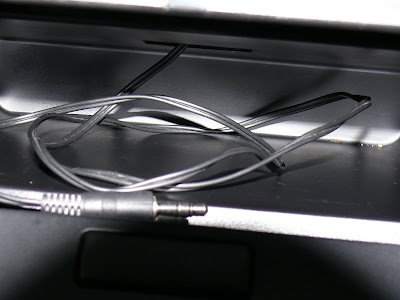Suzuki Grand Vitara, SX4 : How to connect your iPod / MP3 Player (Auxiliary Port)
I bought a GV recently and was quite surprised to see the audio system not having an external line in connection. Googled and found out this site. Thanks to Griff, Steeleus and others, now we have a set of instructions on how to do this. This blog puts all that knowledge into a howto. This will work for your Suzuki Grand Vitara / Suzuki SX4 (2007 and later models) and others with the same Clarion head unit. Here is how the head unit looks.
We need to carefully remove the head unit. For this you need to remove the shiny molded trim first. This is probably the trickiest part.

Connectors behind the head unit
Suzuki Vitara / SX4 Aux Connector Pin Out
USB cable used to connect to the head unit

Cable inserted thru the slot
AUX Success!
I bought a GV recently and was quite surprised to see the audio system not having an external line in connection. Googled and found out this site. Thanks to Griff, Steeleus and others, now we have a set of instructions on how to do this. This blog puts all that knowledge into a howto. This will work for your Suzuki Grand Vitara / Suzuki SX4 (2007 and later models) and others with the same Clarion head unit. Here is how the head unit looks.
We need to carefully remove the head unit. For this you need to remove the shiny molded trim first. This is probably the trickiest part.
- Take a small screw driver, wrap it in 2 to 4 layers of polythene sheet to avoid damaging the fittings.
- Insert the screw driver carefully under the bottom of the shiny plastic trim ; push the screwdriver outwards gently. The molding will open - see pics below.
- Remove the top 5 screws on either side. You can leave the bottom two. Now carefully pull out the audio and AC controls panels. You will need to disconnect the antenna cable, the head unit connector, and the 2 AC unit connectors. The antenna cable is a single wire, you can yank it out. All the others have a release tab in the middle of the connector, press it down and pull out the connector. Do not pull the wires, pull the connector while pressing down the release tab in the middle.
Head Unit

Connectors behind the head unit
- The white connector above is the one we are interested in. The pin-out for the same is below.
Suzuki Vitara / SX4 Aux Connector Pin Out
- You need a connector to get to these pins. After hunting around, I found out that the connector that mates a PC mother board USB port header pins to the USB port itself on the PC Cabinet, will fit the bill. More about this connector here. (See the note on connector at the end of the howto, for an alternate connector). Your friendly neighborhood PC repair person will be able to give you one. You will also need to get a 1k to 2k Resistor from the electronics store, if you don't have one in your electronics junk box. See the connectors (2 rows) below.
USB cable used to connect to the head unit
- You now need to get a stereo jack and cable like the one below and cut off one end of the cable. This coule be an RCA to audio jacks that you can find in any audio store, cut out the RCA end. We will now need to insert the cut end of the cable through the Sun Glass compartment below the 4H-4L Lock knob. See the figure below; we are going to thread the cable through this (The Jack is in the Box lable below) area, so that we dont have to drill holes to bring up the cable.
- Open your sun glass compartment by pressing that button below the label.
There is a ready made slot behind this compartment. You can feel it if you probe for it in the open compartment. If you light up and look carefully you can see it too. See the picture below.

Cable inserted thru the slot
- Insert the cut end of the cable through this slot. You are now ready to wire up the unit.
- Connect the Resistor between Trigger 1 and Trigger 2, Connect the Audio Jack to the Left Right and Signal Ground Wires, solder the connections if you can. Insulate them - use a scotch tape; and tape the resistor to the back of the unit. You can cut off the unused wires.
- Connect the antenna back first! Many of us have had to open up the unit after complete assembly, because the radio stopped working - forgot to connect up the antenna connector. Now connect back the audio unit (one connector more), AC Power and AC Controls cables. Switch on your car ignition and press the CD button on the Audio head unit. You should see the result of your hard work now (see pic below)!
AUX Success!
- Connect your MP3 player line out to the stero jack, turn up the volume and ensure both Left and Right channels are fine. Also tune into your favourite radio station to ensure Radio is functional. Start the Car and check your AC unit is functioning normally. If the AC Control or Power is not properly connected, you will see a "System Check" message on the display.
- Once you are sure all systems are fine, switch off the car, and screw back the panel properly. Put the Silver Trims, starting from the top and working your way back down to the bottom edge.
Note on the Audio Connector:
Instead of the Digital USB connector above, you can use a good low noise analog connector if you are willing to do little fine work. This is the connector where the 3rd pin is blank. This is the one used to connect the CD Audio from a CD driver to the motherboard audio header. You will have to cut out the blank 3rd row and insert the 4th row on to the Trigger 2 Pin on one of the connectors.
Instead of the Digital USB connector above, you can use a good low noise analog connector if you are willing to do little fine work. This is the connector where the 3rd pin is blank. This is the one used to connect the CD Audio from a CD driver to the motherboard audio header. You will have to cut out the blank 3rd row and insert the 4th row on to the Trigger 2 Pin on one of the connectors.
















